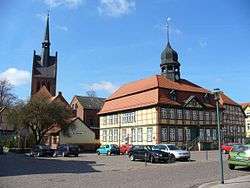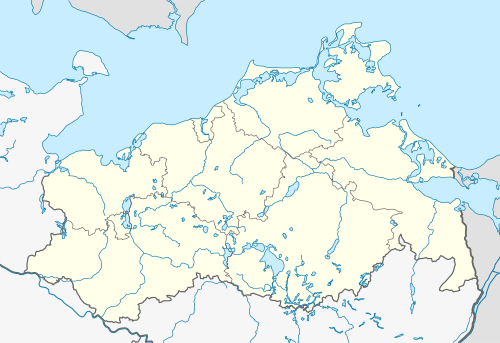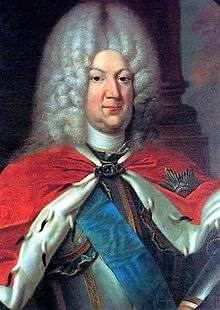Grabow
Grabow (German pronunciation: [ˈɡʁaːbo]) is a town in the Ludwigslust-Parchim district, in Mecklenburg-Western Pomerania, Germany. It is situated on the river Elde, 7 km (4.35 mi) southeast of Ludwigslust, and 34 km (21.12 mi) northwest of Wittenberge. It is twinned with Whitstable, in Kent.
Grabow | |
|---|---|
 Town hall | |
 Coat of arms | |
Location of Grabow within Ludwigslust-Parchim district _in_LUP.svg.png) | |
 Grabow  Grabow | |
| Coordinates: 53°16′N 11°34′E | |
| Country | Germany |
| State | Mecklenburg-Vorpommern |
| District | Ludwigslust-Parchim |
| Municipal assoc. | Grabow |
| Government | |
| • Mayor | Kathleen Bartels (SPD) |
| Area | |
| • Total | 72.08 km2 (27.83 sq mi) |
| Elevation | 26 m (85 ft) |
| Population (2018-12-31)[1] | |
| • Total | 5,633 |
| • Density | 78/km2 (200/sq mi) |
| Time zone | CET/CEST (UTC+1/+2) |
| Postal codes | 19300 |
| Dialling codes | 038756 |
| Vehicle registration | LWL |
| Website | www.grabow.de |
History
The name Grabow is of Slavic Polabian origin, grab means "hornbeam". Names with this root occur often in Mecklenburg. It was only slightly changed as Grabowe (1186, 1252, 1275) and Grabow (1189, 1298). Pope Urban III. mentions castle Grabow for the first time in a letter from February 23, 1186. The city received city law in 1252 from the Count of Dannenberg. On 3 June 1725 the city was destroyed by a great fire. The palace was never rebuilt. At least since the 18th century there were Jews in the city, who left behind a synagogue and a cemetery. Both of them were damaged during the Kristallnacht. The Jews were murdered during the German occupation of the town that began in 1939. Most were sent to nearby Chelmno and gassed there.
The historical center of Grabow is distinguished by its close core of timber-framed houses of the 18th century.
From 1815 to 1918, Grabow was part of the Grand Duchy of Mecklenburg-Schwerin. Otto Plath, the father of Sylvia Plath, emigrated from Grabow to America. On 1 January 2016, the former municipality Steesow became part of Grabow.
The painter Wilhelm Langschmidt was born in Grabow. He settled in the Elgin valley in South Africa. The town which grew around his trading store there still bears the name Grabouw, after his hometown.[2]
Number of inhabitants
- 1877: 4,200
- 1910: 5,500
- 1939: 5,900
- 1946: 8,900
- 1970: 8,500
- 1984: 8,600
- 1990: 8,098
- 1995: 7,240
- 1997: 6,934
- 2000: 6,741
- 2005: 6,231
Pictures
- Timber-framed houses
 Pferdemarkt 5
Pferdemarkt 5
 Große Straße
Große Straße Grabow Town hall
Grabow Town hall Grabow
Grabow
Sons and Daughters of Grabow


- Frederick, Duke of Mecklenburg-Grabow also Friedrich zu Grabow (1638–1688), Duke's Grave in the crypt of the castle at Grabow.
- Karl Leopold, Duke of Mecklenburg-Schwerin (1678–1747), duke at the time of the Grabower Brandes of 1725
- Karl Leopold, Duke of Mecklenburg-Schwerin (1678–1747), reigning duke in Mecklenburg-Schwerin
- Christian Ludwig II, Duke of Mecklenburg-Schwerin (1683–1756), reigning duke in Mecklenburg-Schwerin
- Sophia Louise of Mecklenburg-Schwerin (1685–1735), Queen of Prussia
- Duke Louis of Mecklenburg-Schwerin (1725–1778), Hereditary Prince of Mecklenburg-Schwerin
- Marco Küntzel (born 1976), footballer, played from 1981 to 1990 at Empor Grabow
- Wilhelm Langschmidt (1805–1866), German-South African painter
- Bernhard Leverenz (1909–1987), politician (FDP)
Personalities who lived and worked in Grabow
- Frederick, Duke of Mecklenburg-Grabow (1638-1688), resided from 1669 until his death in Grabow
- The Mann family, a Hanseatic family
- Volkwin Marg (born 1936), architect
- Bastian Reinhardt (born 1975), footballer, played at Empor Grabow / Grabower FC, now sports director of Hamburger SV
References
- "Statistisches Amt M-V – Bevölkerungsstand der Kreise, Ämter und Gemeinden 2018". Statistisches Amt Mecklenburg-Vorpommern (in German). July 2019.
- G. de Beer, A. Paterson, H. Olivier: 160 Years of Export. PPECB. Plattekloof, South Africa. 2003. ISBN 0-620-30967-9